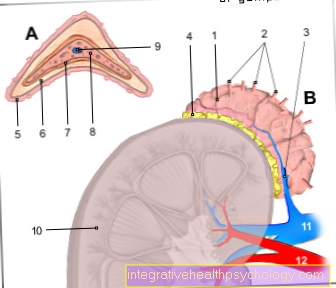Basalioma on the nose
introduction
A basalioma of the nose is a malignant skin disease that is also known as basal cell carcinoma or basal cell epithelioma. The term white skin cancer is also common. Basalioma only affects the cells of the skin epithelium. This tumor is one of the most common tumors in Europe.

Basaliomas are particularly common on the nose. This is not only unfavorable because they are correspondingly noticeable and annoying at this central point on the face, but also because the operation of a basalioma on the nose is always a difficulty. In any case, you want to avoid the patient's olfactory ability to decrease after an operation.
On the other hand, it is particularly important to act quickly with a basalioma, which is located on the nose. If it is an aggressive form of basalioma that not only grows superficially but also deeply, it can happen relatively quickly that the surrounding bony or cartilaginous structures are attacked by tumor tissue and thereby destroyed, which is a large number of Can bring complications.
In rare, extremely serious cases, a skin transplant or even the reconstruction of the face with prostheses may be necessary after therapy.
Please see the main article for more information Basalioma.
Symptoms of a basalioma of the nose
The symptoms of nasal basalioma are very unspecific and usually do not cause pain. A skin change, reminiscent of a string of pearls in a circle, forms on the affected area. In the early stages, a basalioma is often not recognizable or is mistaken for common skin blemishes.
Read more on this topic at: Symptoms of a basalioma
Localization of a basalioma
It is assumed that the UV radiation of light is mainly responsible for the development of a basalioma. The reason for this assumption lies in the exposure sites, i.e. the sites that are particularly often affected by basalioma.
It is above all skin regions of the human body that are frequently exposed to sunlight. Basalioma in particular often affects parts of the face.
The forehead and temple regions and the region on the nostrils should be mentioned. But arms, hands and skin around the scalp and hair follicles can also be affected by a basalioma. It is assumed that numerous cells are repeatedly damaged by the incoming UV radiation. The body's own repair system runs millions of times over the defective cells and repairs them. For reasons that are unclear, this repair system sometimes does not work, which means that the defective cells are not repaired and can continue to divide unchecked. As a result, a tumor from malignant cells forms.
Read more on this topic at: Basalioma on the face
Causes of a basalioma on the nose
By far the most important risk factor for the development of a basalioma is the long-term exposure of the skin to UV radiation in sunlight. As a result, this type of tumor occurs mainly in areas of the skin that are regularly exposed to a lot of solar radiation: 80% of basaliomas form on the face, most of them are in the strip that runs from the hairline over the nose to the upper lip.
diagnosis
The diagnosis of basal cell carcinoma is usually made by a dermatologist.
In advanced stages, a visual diagnosis is sometimes possible or is indicative. In any case, a biopsy must be taken and examined in a pathological laboratory. Since the risk of cells being carried over is very high, the entire abnormal area of skin is usually removed and sent in.
Regular skin cancer screening is also useful for the early detection of a basal cell carcinoma.
Read more about this topic here:
- How do you recognize skin cancer?
- biopsy
How do I recognize a basalioma of the nose in the early stages?
Since the basalioma grows very slowly, it generally has very good prospects of a cure. It is important that the basalioma is differentiated from a pimple or skin appendage. The appearance of a basalioma can vary. At the beginning, for example, there may be a light lump on the nose or in the corner of the nose. On the other hand, the knot can also be reddish in color. In addition, the basalioma sometimes shows up as a red spot on the skin. These lumps or spots will slowly continue to spread. In some cases there is a central indentation. The basalioma can bleed in the course. A crust will then form on this bleeding area.
Treatment of a basal cell carcinoma of the nose
Once a basal cell carcinoma has been diagnosed, photodynamic irradiation of the nose can be carried out in addition to the surgical removal. Recurrences are always possible, but the prognosis is generally good.
Read more on the topic: Therapy of a basalioma
The operation of a basalioma on the nose
The therapy of first choice for treating a basalioma of the nose is this radical, microscopic controlled Excision.
This is usually done under local anesthesia or, if desired, under general anesthetic the degenerated epithelial cells of the nose are surgically removed. The surgeon uses a scalpel to cut around the degenerated area at a certain safety distance and, if possible, removes all degenerate cells.
Since, on the one hand, it is usually a relatively small area of degeneration and, on the other hand, the location on the face makes very precise surgery necessary, the surgeon operates with the help of a microscope.
This is usually attached to the surgeon's head and enables a strong magnification. In this way, unnecessarily large excisions can be prevented - and the basalioma completely removed.
As an alternative to the classic operating room, laser surgery, cryosurgery and radiation using X-rays are also available. This can sometimes be necessary, especially in older patients, if an invasive procedure cannot be carried out.
- In laser surgery, the removal is carried out using a high-energy laser.
- Cryosurgery is a surgical procedure in which the basalioma is destroyed by exposure to cold. However, the last-mentioned procedure only promises success with small and superficial basaliomas.
Basal cell carcinoma is therefore usually treated with surgery. For reasons of infection, a bandage must be worn for a few days to weeks after the operation to prevent inflammation. The tissue usually grows back within weeks to months and fills the excised gap.
The Excidate is always kept for follow-up examination, and in the pathology for examination and to the correct grading passed on. Under grading one understands a classification of the tumor, the removed areas, and an assessment of the benign or malignancy.
True, the basalioma is a semimaligner, so "semi-vicious“Tumor, however, due to its low rate of metastasis, a very good prognosis can be expected with complete surgical excision. Also the fact that Basaliomas mean to grow slowly over months to years, comes towards a favorable outcome. However, one should not wait too long with an operation, since with enough time a semi-malignant tumor can become malignant, i.e. malignant.
Skin graft
A skin graft is performed after the basal cell has been surgically removed. It depends on how big the basalioma was or how far it has spread in the area. If the wound cannot be closed due to its size, a skin graft must be carried out to cover the wound. The sliding-swiveling flap technique can be used when tissue defects develop. Here, the surgical wound is covered with healthy skin from the area. The edges of the wound and the edges of the skin graft are sutured together. Depending on how deep the surgical wound is, either only superficial layers of skin or deeper layers of skin are taken to close the skin defect. Another possibility is the so-called rotation flap, whereby the skin flap is prepared and twisted into the skin defect. Here, too, the edges are sewn.
Read more on this topic at: Skin graft





























